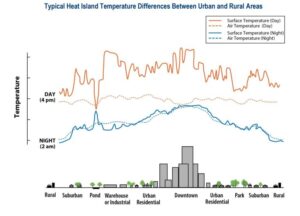Millions of people living in and around cities experience summertime temperatures that are higher than those in surrounding natural areas. These urban “heat islands” increase energy demand for air conditioning, raise air pollution levels and can cause heat-related illness and death.
As temperatures continue to ruse due to climate change, urban areas are more likely to experience more frequent, more intense and longer heat waves. Fortunately, there are proven actions communities can take today to keep cool in the future.
What is a Heat Island?
Heat islands are zones of relative warmth created by urban air and surface temperatures that are higher than those of nearby rural areas. Air temperatures in a large city can be 2-22 degrees Fahrenheit higher than its rural surroundings.
The sketch below shows a hypothetical city’s heat island profile at two times during a 24-hour period, demonstrating how temperatures typically rise during both the day and night as you move from rural areas towards dense downtown areas.

What causes Heat Islands?
Heat islands form when cities replace natural land cover—trees, grass, wetlands—with pavement and buildings. These changes lead to higher urban temperatures because:
- Removing trees and vegetation eliminates the natural cooling effects of shade and evaporation of water from soil and leaves.
- Pavement, rooftops and other non-reflective surfaces absorb heat during the day and release it at night, inflating overnight temperatures.
- Tall buildings and narrow streets reduce wind flow and heat air that is trapped between them.
- Waste heat from vehicle, factories, and air conditioners add warmth to the air, further increasing the heat island effect.
How do Heat Islands affect us?
Higher temperatures affect people’s health, air and water quality and the amount of energy we use for summertime cooling.
Heat islands can intensify extreme hot weather, which can cause breathing problems, heat cramps, heat stroke and may lead to illness or even death—especially in vulnerable populations such as the elderly.
Heat islands raise energy demand to power air conditioning, which in turn can increase utility bills and increase power plant emissions of carbon pollution that causes climate change. Higher temperatures also accelerate the chemical reaction that produces ground-level ozone, or smog.
Hot pavements heat up storm water runoff, which can hurt aquatic life in local waterways.
Heat Islands are responsible for 5-10% of summertime electricity demand, leading to higher electricity bills, pressure on the electricity grid and brownouts and blackouts.
How can communities cool down?
Communities that want to cool down have options. They include installing reflective cool roofs’ planting trees and vegetation, including “green” roofs and cool paving materials for roads, sidewalks and parking lots. Green roofs replace heat-absorbing traditional roofing materials with plants, shrubs and small trees.
What Are the Benefits of Cooling Down?
Implementing cooling strategies across a community has many benefits, including reducing summertime temperatures, lowering energy use and costs, curbing air pollution, and alleviating heat related health issues.
By adding these strategies to long-term local and regional planning, communities can also prepare for or adjust to higher temperatures and changing conditions that come with climate change. For instance, planting trees helps prevent flooding while also lowering local temperatures.
For more risk management solutions, contact INSURICA today.
This is not intended to be exhaustive nor should any discussion or opinions be construed as legal advice. Readers should contact legal counsel or an insurance professional for appropriate advice.
About the Author
Share This Story
Related Blogs
Personalization Now a Baseline Expectation in Employee Benefits
In 2025, personalization has moved from “nice to have” to “non-negotiable.” Employees expect benefits that reflect their individual needs, values, and life stages. Static, one-size-fits-all plans are being replaced by flexible, modular offerings that empower employees to choose what matters most.
Fertility, Family Planning, and Parental Leave Are Front and Center
In 2025, family-building support has emerged as a defining priority in employee benefits strategy. Fertility coverage, inclusive parental leave, and caregiving support are no longer niche offerings — they’re central to how employees evaluate workplace value. As life paths diversify and caregiving responsibilities expand, benefits managers are rethinking what it means to support the whole employee.
Gag Clause Attestation Deadline: December 31, 2025
Employer-sponsored group health plans must submit their 2025 Gag Clause Prohibition Compliance Attestation (GCPCA) to CMS by December 31, 2025, to confirm compliance with federal transparency rules. This annual filing covers the 2024 calendar year and applies regardless of employer size or funding arrangement.







